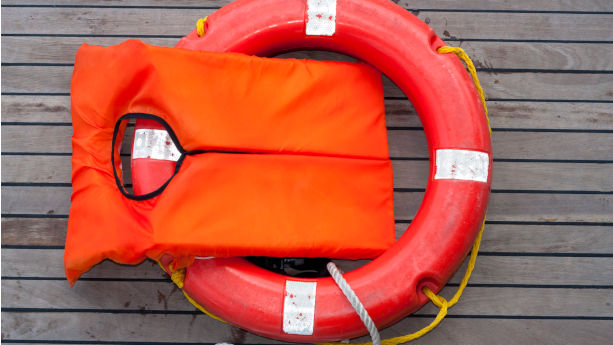
Swimming aids include products such as personal flotation devices and life jackets that help users stay afloat during emergencies or when learning how to swim. Such products are subject to various regulations, standards, labeling, and testing requirements in the United States.
This article covers 46 CFR Part 160, UL standards, the CPSIA, California Proposition 65, and other compliance requirements applicable to swimming aids.
Covered Products
- Lifesaving equipment
- Personal flotation devices (PFDs)
- Swimming aids
- Life jackets
Content Overview

FREE CONSULTATION CALL (US, EU & UK)
- Request a free 30-minute call with Ivan Malloci to learn how we can help you with:
- Find product requirements
- Certification and labeling
- Lab testing
Lifesaving Equipment (46 CFR Part 160)
46 CFR Part 160 – Lifesaving Equipment requires importers and manufacturers of life preservers – which includes personal flotation devices (PFDs) – to construct their products in such a manner that they can function as intended in weather conditions and temperatures that might be anticipated when using a life preserver.
The regulation also requires life preservers to:
- Provide the wearer with upright or slightly rearward support in the water
- Be highly visible in the water
- Being able to be adjusted fast, to fit the wearer
- Have a simple design
You can find additional general characteristics in section 160.001-2.
Product scope
46 CFR Part 160 covers life preservers, such as the following products:
- Jacket type life preservers
- Buoyant vests for adults and children
- Inflatable lifejackets
Approval procedure
Section 160.001-3 “Procedure for approval” requires applicants to submit a life preserver prototype with details for preapproval review to the US Coast Guard (USCG), which is authorized to approve life preserver designs. Below we list some of the requirements.
| Design type | Application requirements |
| Conventional life-preserver design |
|
| Non-standard life-preserver design |
|
Note that additional requirements might apply according to the specific type of life-preserver.
Marking requirements
Marking requirements might vary according to the product. For example, section 160.002-6 sets the requirements for Life Preservers, Kapok, Adult and Child (Jacket Type), Models 3 and 5. This includes the following:
a. The text in the marking or labeling should be placed on the front of the product in waterproof ink
b. The text should include the following information:
“Inspected and tested in accordance with U.S. Coast Guard regulations.
Kapok buoyant material provides a minimum buoyant force of (25 lb. or 16 1⁄2 lb.).
Do not snag or puncture inner plastic cover.
Approved for use on all vessels by persons weighing (90 lb. or more, or less than 90 lb.).
U.S. Coast Guard Approval No. 160.002/(assigned manufacturer’s No.)/(Revision No.); (Model No.).
(Name and address of manufacturer or distributor.).
(Lot No.).”
Documentation requirements
Section 160.001-3(b) requires applicants submitting applications for the preapproval review of the design of a life preserver to ensure that their application contains information such as the following, per section 159.005-5:
a. Manufacturer’s, and factory’s, name and address
b. Two sets of general plans or specifications
c. A sample, and description, of the equipment or material
d. A manufacturer-signed statement
Note that, also in this case, documentation requirements might vary according to the product.
Testing requirements
In general, lifejacket manufacturers are required to carry out inspections and testing performed by USCG-accepted laboratories.
For example, section 160.002-5 “Sampling, tests, and inspections” mandates manufacturers of life preservers Kapok, Adult and Child (Jacket Type), Models 3 and 5 to conduct production tests and inspections such as the following:
Buoyancy test
- Submerge life preserver for 48 hours
- Pad inserts to remain undisturbed
- Measure buoyancy post-submersion
Buoyancy required
- Model 3: for adults, > 25lb buoyancy
- Model 5: for children, > 16.5lb buoyancy
USCG Accepted Laboratories
Here are some examples of USCG-accepted laboratories
You can find more laboratories on the USCG website.
Safety and Health Regulations for Construction (29 CFR Part 1926)
Subpart E of the OSHA’s Safety and Health Regulations for Construction sets requirements for personal protective and life-saving equipment used in the workplace. This includes requirements for providing USCG-approved equipment to employees that work near or above the water.
Product scope
Section 1926.106 concerns equipment for employees working above or near water, and it covers products such as the following:
- Life jackets
- Buoyant work vests
- Life preservers
General requirements
Here are some examples of the requirements for employers under Section 1926.106:
a. Provide USCG-approved buoyant work vests or life jackets to employees working close to water where there is a danger of drowning
b. Inspect the aforementioned products before and after each use for defects that may change their buoyancy or strength, as employees should not use defective units
c. Provide within every 200 feet, and make available for emergency operations, ring buoys with a minimum of 90 feet of line
UL Standards
Underwriters Laboratories (UL) develops a wide range of standards to determine the safety and performance of products such as PFDs and other swimming aids. UL also works with the USCG to test and certify PFDs per the requirements in 46 CFR Part 160.
Generally speaking, UL standards are voluntary. However, a given regulation might incorporate some standards. In this case, compliance with the standard becomes mandatory. For example, 46 CFR Part 160 incorporates by reference UL 1517.
Examples
In this section, we list a few examples of UL standards relevant to swimming aids.
ANSI/CAN/UL 12402-4 – Personal Flotation Devices – Part 4: Lifejackets, Performance Level 100 – Safety Requirements
This standard specifies safety requirements for lifejackets classed at performance level 100, and it adopts the requirements of ISO Standard for Personal Flotation Devices – Part 4, with some changes.
According to this website, performance level 100 means that the PFDs are intended to be used by people that are waiting for rescue in sheltered waters. The device might not be sufficient to protect the wearer in rough waters.
The standard applies to lifejackets designed for the following age groups:
- Adults
- Children
- Infants
UL 12402-5 – Personal Flotation Devices – Part 5: Buoyancy Aids (Level 50) – Safety Requirements
This standard describes safety requirements regarding performance level 50 buoyancy aids for adults and children. These buoyancy aids must adhere to conditions such as the following:
- Have a minimum buoyancy of 50 Newtons
- For use in sheltered waters
- For use with help and rescue close by
UL 1517 – Standard for Hybrid Personal Flotation Devices
The requirements in this standard cover wearable buoyant devices that observe the following conditions:
- At least one compartment is inflated by gas or other media
- The product is made of inherently buoyant material
CPSIA
The Consumer Product Safety Improvement Act (CPSIA) establishes consumer product safety requirements for toys and products meant for use by children aged 12 and younger. These products also include swimming aids, such as inflatable swimming armbands for young children.
The CPSIA requires importers and manufacturers to ensure that their products:
a. Are accompanied by a Children’s Product Certificate (CPC)
b. Carry a tracking label on the product and its packaging
c. Are tested compliant by a CPSC-accepted lab against relevant standards and requirements
ASTM Standards
The American Society for Testing Materials (ASTM) develops and sets consensus standards for importers and manufacturers to use. These standards cover a variety of products, including toys and personal protective equipment.
During our research, we could not find any ASTM standards that specifically govern the safety of swimming aids. Even if this is the case, manufacturers may still use other relevant standards to assess the safety of their swimming aids.
For instance, we found that several companies claim that their swimming aids products comply with ASTM F963-17, which is a standard developed for the safety of toys. This includes the following companies:
Additionally, the Water Safety Council of Fresno County, California, explains that products such as floaties and water wings are recognized as “toys” and are required to conform to requirements in ASTM F963-17.
Other Requirements
The following regulations, though not applicable specifically to swimming aids and flotation devices, are still relevant as the regulations apply to general products that might include the products mentioned above.
Model Toxics in Packaging Legislation
The Model Toxics in Packaging Legislation, developed by the Toxics in Packaging Clearinghouse (TPCH), is not federal law.
The legislation, adopted by 19 states since 2021, was developed to limit to a maximum of 100 ppm the intentional addition of heavy metals and chemicals such as the following:
- Cadmium
- Chromium IV
- Lead
- Mercury
- Orthophthalates
- PFAS
Importers and manufacturers are also required to provide a certificate of compliance.
Uniform Packaging and Labeling Regulation (UPLR)
The Uniform Packaging and Labeling Regulation (UPLR) is not a federal regulation, but 45 out of 50 states have adopted it into law. The UPLR covers packaging of both consumer and non-consumer products across the US and requires importers and manufacturers to label their products with the following:
- Declaration of identity
- Declaration of responsibility
- Declaration of quantity
Importers and manufacturers are mandated to adhere to labeling requirements such as the following:
- Provide information in English
- Make the lettering conspicuous
- Ensure the color contrasts with the background
California Proposition 65
California Proposition 65 requires businesses to inform consumers in California if their products may contain restricted substances, by providing such information on warning labels.
Products such as swimming aids may contain substances that are restricted by California Proposition 65 list. Here are some examples of these substances:
- Phthalates
- BPA
If you want to ensure that your product does not contain restricted substances in an amount higher than the one allowed by California Proposition 65, you should test the product against the requirements of the proposition.
Country of Origin Marking
Products imported, manufactured, or sold in the United States, including swimming aids, are required to bear a country of origin marking. Generally, this marking comes in the form of a “Made in” label. For example, swimming aids manufactured in China must carry a Made in China label.
Importers and manufacturers can print or engrave the label, or even place it on a tag and attach it to the product.



















